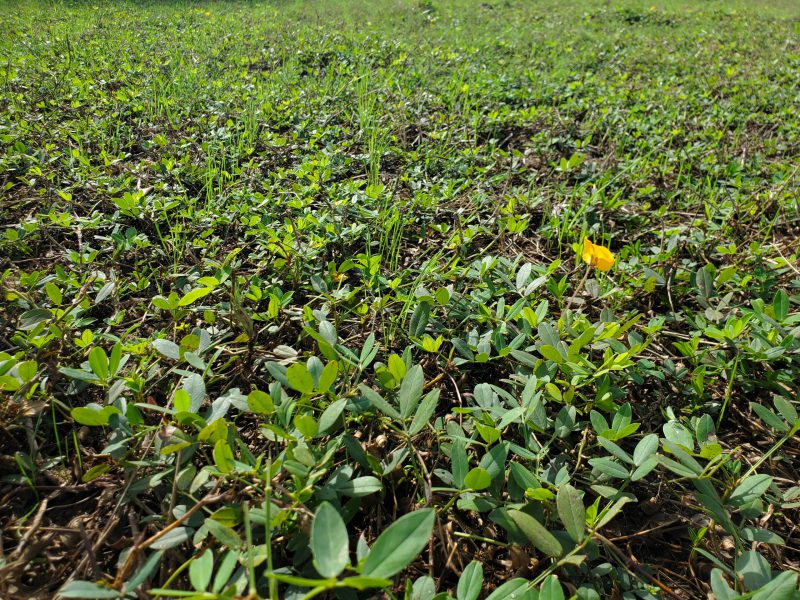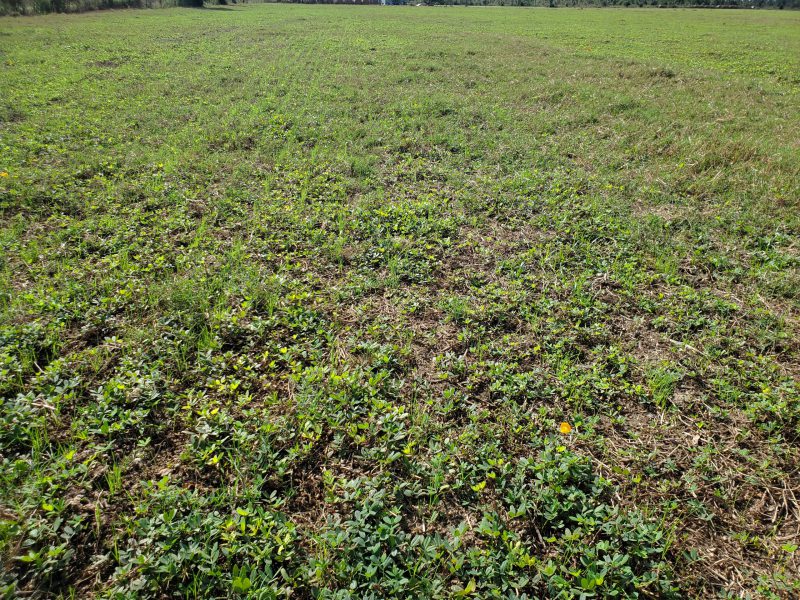In recent years, thanks to the work of Forage Agronomy Specialists Dr. Jose Dubeux, Dr. Ann Blount and others at the NFREC Marianna, many Panhandle cattlemen have begun integrating perennial peanut (Arachis glabrata) into traditional bahiagrass and bermudagrass pastures. These integrated grass/legume mixtures provide many benefits to cattle producers, namely reduced nitrogen fertilizer applications, increased cattle performance, and ultimately a reduction in total production costs. However, any new technology or growing method, no matter how beneficial, comes with some hesitation from producers, particularly when first adopting and integrating perennial peanut into conventional, grass pastures.

Grass/perennial peanut mixed pasture in Calhoun County with cool season ‘Attain’ ryegrass forage no-till drilled in mid-October. Photo courtesy of Daniel Leonard.
–
One of the main hesitations growers have is a lack of information regarding overseeding cool-season forages into dormant grass/legume systems. Only recently has there been any information to share on this topic. The following is a rundown of a couple of the most frequently asked questions I get regarding overseeding cool-season forages into perennial peanut pastures, along with some answers!
–
1. Will winter overseeding hurt my perennial peanut regrowth in the spring?
The classic “It depends” answer applies here. Any effect on perennial peanut spring regrowth depends almost solely on the type of cool season forage chosen by the producer. Small grains, such as cereal rye, oats and wheat, planted at recommended rates after frost (when perennial peanut typically goes into dormancy), almost certainly will not affect perennial peanut that fall. As long as the winter forage is grazed or harvested by early spring green-up, it will not likely harm perennial peanut summer yields either. On the other hand, annual ryegrass tends to be later maturing, and if not removed by mid-March, there might be some modest yield reduction in early summer, due to direct competition for resources, particularly light and water. (Note: due to the possibility of a dry La Nina winter in 2020, utilizing cereal rye and/or triticale in place of or in addition to oats or wheat may provide some protection against drought impacts)

Calhoun County mixed grass/perennial peanut pasture grazed very short and then no-till planted in mid-October. Notice cool season ‘Attain’ ryegrass emerging. Photo courtesy of Daniel Leonard.
–
Clovers can also be overseeded on dormant perennial peanut, but they are best mixed with small grains rather than planted alone. Crimson clover is an early maturing option, while red, ball, and berseem clovers can continue producing low amounts of forage into the early summer. With that in mind, you might want to avoid the later season clovers for a perennial peanut hayfield, but it should be fine to use in a mixed pasture. If a forage mix containing annual ryegrass or later maturing clover species is used, producers should be diligent about grazing it down heavily in spring to reduce negative impacts on perennial peanut regrowth.
–
2. Does the perennial peanut provide any fertility to my cool season forages?
The short answer is, probably not much. In conversations with Dr. Cheryl Mackowiak, Associate Professor of Soil & Water Sciences at the UF/IFAS NFREC, she indicated that, while perennial peanut’s nitrogen fixing nature delivers clear and known fertility benefits to its summer grass companion, she found little of that nitrogen was available to provide for the nitrogen (N) needs of the cool-season forage. She recommends applying a standard N rate of 30 to 50 lbs N/acre/season, along with at least 30 lbs K2O and 10 lbs S/acre, unless ammonium sulfate is used as the N source.
If you’ve already integrated perennial peanut into your grass pastures or have been thinking about it, hopefully these tips will help answer potential questions and dispel concerns you may have had regarding your cool season grazing plan. If you have any further questions on this or other agronomic topics, please contact your local UF/IFAS Extension Office.
–
References
Dr. Cheryl Mackowiak, Associate Professor Soil & Water Sciences, UF/IFAS North Florida Research & Education Center (NFREC, personal communication)
Dubeux, J., L.E. Sollenberger, J. Vendramini, M. Wallau, A. Blount, L. Garcia-Jimenez, E. Santos, and D. Jaramillo. 2018. Strip-planting rhizoma peanut into grazing systems. EDIS SS-AGR-421. Printer friendly PDF version: https://edis.ifas.ufl.edu/pdffiles/AG/AG42100.pdf
Dubeux, J., Mackowiak, C.,Blount, A., Wright, D., and Dantas, L. 2019. Overseeding Rhizoma Perennial Peanut Pasture and Hay Fields during the Cool Season. EDIS #SS-AGR-426. Printer friendly PDF version: https://edis.ifas.ufl.edu/pdffiles/AG/AG42600.pdf
- Stay Ahead of Peanut Fungal Pathogens This Summer - August 8, 2025
- Panhandle Cotton Acres Are Down in 2025– Here’s the Reason - July 11, 2025
- It Snowed, But Has This Been a Historically Cold Winter? What the Data Says. - January 31, 2025
